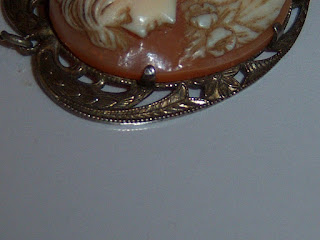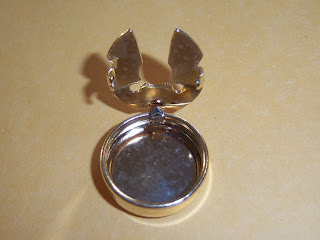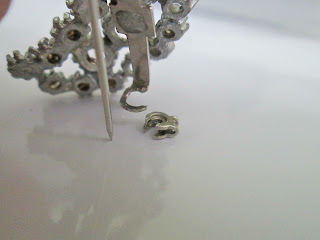Today I will discuss a few simple ways to judge if your shell Cameo is real or, a close second. Please forgive the letter spacing as the blog has gone a little wonky on me. Let's start with a cameo I have in the shop and take a look at what you should look for when buying an antique shell cameo....
Lets begin by looking at the back of the cameo. In the first photo above, you will find a smooth surface. It isn't uncommon to see scuffs or fine cracks from age and use. Don't run from the cameo if you find them, they are normal and should not worry you too much. Deep cracks will lower value. The cameo back should feel smooth and have a bit of a glass like shine. Most shell cameos are in ranges of pink (or blue). Not all, but the majority. So far, all looks well. What you do not want to see are small pits or pinholes all over the back. Another thing you do not want is a milky color or, melted look. These generally do not indicate an antique piece and you should probably keep searching.The next thing you should see is a concave back. This means the Cameo's shell should be indented. Imagine the indented bowl of a teaspoon and you will exactly get it. If it is a little hard to tell, as in this photo above, feel it. As your fingers run along the face they will feel the indent. The outside of shells are not flat. Neither should your Cameo be flat. Hold the Cameo up to the light. It will be translucent. You should be able to see the opposite side of the cameo just slightly, as if looking through a haze.
The third thing you want to do, and I caution you on the danger, is to heat test your piece. Now if you are going to spend money on an expensive antique Cameo, make sure whoever you are buying this from (other than a reputable jeweler) is willing to do this for you. It does not hurt the piece. It doesn't damage the piece in any way. Unless, it's fake. There is no reason I can think of where a person would not heat test the Cameo for your piece of mind. Below, is the implements that I used to heat test this particular piece. You can do this as well, it isn't hard. For this you can use any small metal sewing needle, piece of wire, anything small metal and pointy. For this photo, I chose an old brooch that was beyond help. I am using a clamping item available at any hardware store in the fishing aisle. They are used to pull hooks out of a fish but, they are useful for jewelry if you want to change bails or jump rings. This pair locks shut so there is no chance the pin will come out and burn you. Stuck? Use a set of locking vice grips. Whatever you do, make sure your holders lock. The pin will be very hot. Too hot to touch. You don't want to slip up and get a nasty burn. So, don't just use a set of regular pliers. Any item you use should lock. O.K., enough safety blah-blah-blah.
Unlike me, you should now lay your Came upside down on a towel or, other soft item. The next thing we need to do is to get that pin hot! Use a lighter, use a torch, use your stove (watch your sleeves) anything at your disposal. Once you have your pin hot, lightly place it on the Cameo in a prearranged inconspicuous spot. If it creates a hole, you don't want it to be the first thing you see if you intend to keep the fake. I prefer to test the lower portion. As the pin is hot, you will not need a lot of pressure. Hold on to the count of three. Remove the testing items and set them down on a heat friendly surface like the metal on your stove top. If your Cameo is a genuine shell, no harm will have been done. What you don't want to see is a hole left by the pin. This means the piece has melted and is not a true antique or vintage shell Cameo. Sorry....
Now lets take a look at the front. Here we see a lovely young confident lady. Lets take a closer look at her details. The details you should look for. Turn the Cameo on its side. The white on the front of the cameo should just graze the surface. You don't want to see a large lump of excessive white. Though not shown, between the nose and hair you can see the shell and a thin coating of white. Make sure you check all angles because the white can appear to be large face on but, on closer inspection it is not. The next thing we will check on this lady is her hair. Notice how the hair is upswept. Most antique Cameos have this feature as opposed to hair hanging down which is more of a vintage Cameo trait. We next want to look at that cute little nose. It should be Romanesque. This was the style most adopted for antique Cameos. Another common feature of an antique shell Cameo is the attention to detail. Crisp, distinguishable lines as seen here in her hair, mouth, eyes, and chin. Flowers are another great sign. They were often used to adorn hair and clothing in a Cameo of the era. Cameos of this age can face either right or left. Right facing Cameos being the most common. This one was possibly made by a "southpaw".
Again, on the bottom we see lots of attention to detail. The dress neckline has nicely carved lines and is adorned on the left with a spray of leaves and flowers.
Just one more part on the front to focus on. The edges of the shell Cameo. How did they create these miniature works of art? Well, they were carved by craftsmen. And, that is exactly what you want to see. Check the edges for cuts or "whittle" in the shell as shown under the prong in the picture below. Look a little further up and you can see the edges are not perfect. They have been expertly whittled down to create the masterpiece from a single shell.
In the end, beauty is in the eye of the beholder. Real, not real, shell, stone, coral, everyone has their own idea of what they want in a vintage or antique Cameo piece. Real antique cameos are not an everyday wear. You should consider buying a vintage, rather than antique, Cameo piece for those non formal occasions. But the beauty of a true antique cameo is a thing to behold. Either way, here are the end things you should know about your antique shell Cameo. The settings. They came in a surprising number of materials including silver (like ours), gold (but not white gold), and brass. Brass was a surprise to me but I have seen garnets more than enough times set in brass. At any rate, I hope you enjoyed this post and if you have any suggestions or you feel I should correct something, just post a comment and I will get right to it. I am not an expert or jeweler but, I hope this has helped in your Antique Cameo quest.
Please note that there are very nice fakes out there that will pass the heat test. Please take all things into account when choosing your Cameo. If in doubt, consult a vintage jeweler specialist.
My personal antique Cameo checklist:
1. Cameo must have a concave back.
2. Cameo does not have a lot of small pit marks.
3. Cameo does not have a white, milky, or foamy looking back.
4. Cameo has very sharp, distinct, carving.
5. Cameo has ornate flowers and other adornments.
6. Cameo has upswept hair (not hair that hangs down which indicates a vintage Cameo).
7. Cameo has an older style setting with patina-unless cleaned.
8. Cameo's white parts are low to shell and blend into the carving.
9. Cameo has carving marks on, and around, the edges.
10. Cameo's nose is not "rounded".
11. Cameo should be translucent when held to the light.
AUTHOR: Rob Marshall
Please share us with your friends.
Our blog: http://vintagehelp.blogspot.com
Our shop: http://



































